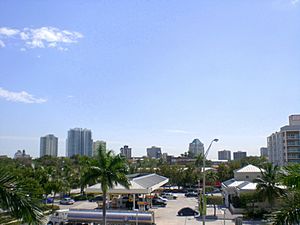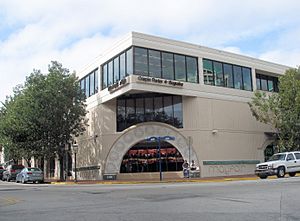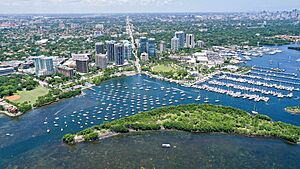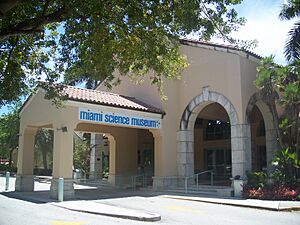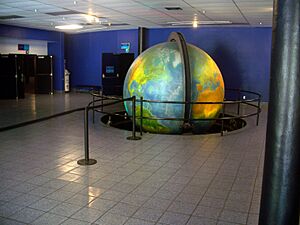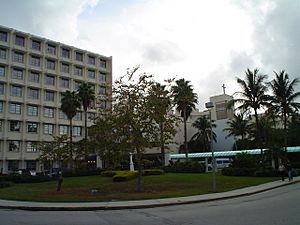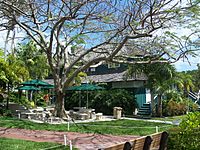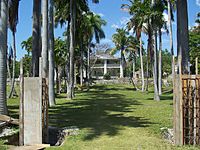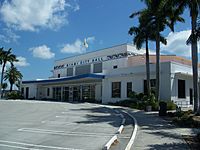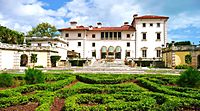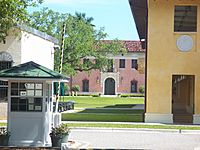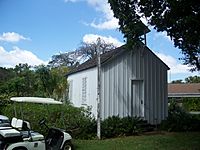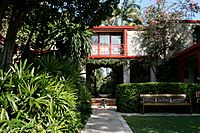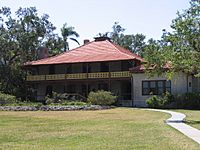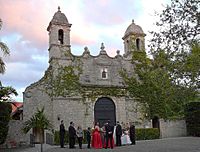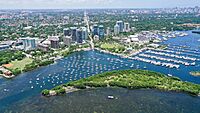Coconut Grove facts for kids
Quick facts for kids
Coconut Grove
|
|
|---|---|
|
Neighborhood of Miami
|
|
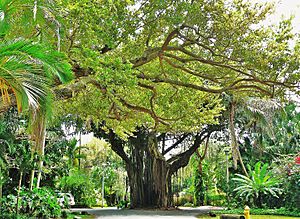
Typical street in Coconut Grove, showing heavy vegetation characteristic of the hammock.
|
|
| Nickname(s):
The Grove
|
|
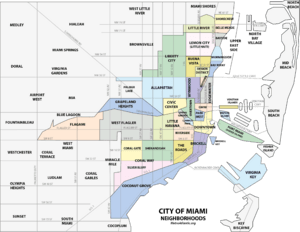
Coconut Grove neighborhood in Miami
|
|
| Country | United States |
| State | Florida |
| County | Miami-Dade County |
| City | Miami |
| Settled | 1825 |
| Annexed into the City of Miami | 1925 |
| Subdistricts of Coconut Grove |
Neighborhoods list
Center Grove
Northeast Coconut Grove Southwest Coconut Grove West Grove or Black Grove |
| Area | |
| • Total | 5.607 sq mi (14.52 km2) |
| Elevation | 13 ft (4 m) |
| Highest elevation | 24 ft (7 m) |
| Population
(2010)
|
|
| • Total | 20,076 |
| • Density | 8,006/sq mi (3,091/km2) |
| • Demonym | Grovite |
| Time zone | UTC−05 (EST) |
| ZIP Code |
33133
|
| Area code(s) | 305, 786 |
| Website | www.coconutgrove.com |
Coconut Grove, often called “The Grove,” is a lively and the oldest neighborhood in Miami, Florida. It's a special part of Miami-Dade County. The area is known for its many trees and green spaces.
Coconut Grove is located by Biscayne Bay to the east. It is south of Brickell and The Roads neighborhoods. It is also east of Coral Gables. The name was first spelled "Cocoanut Grove." But "Coconut Grove" became the official spelling in 1919. This was when the city was officially formed.
In 1925, the city of Miami grew bigger. It added the city of Coconut Grove and most of Silver Bluff. Today, Coconut Grove mostly matches the 33133 ZIP Code. This ZIP Code also includes parts of Coral Way and Coral Gables. People who live here are proud that it is one of Miami's greenest areas.
You can get to Coconut Grove using the Miami Metrorail. There are stations at Coconut Grove and Douglas Road.
Contents
- A Look Back: History of Coconut Grove
- What's Happening: Economy and Fun
- Who Lives Here: Demographics
- Getting Around: Transportation
- Learning and Culture: Education and Institutions
- Cool Spots: Points of Interest
- Green Spaces: Parks
- Famous Faces: Notable People
- Old Buildings: Historic Coconut Grove
- See also
A Look Back: History of Coconut Grove
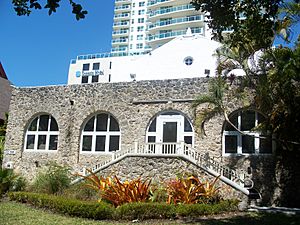
Coconut Grove was settled by different groups of people. The first settlers arrived in 1825. This was when the Cape Florida lighthouse started working. John Dubose was the lighthouse keeper.
Early settlers came from the Northeastern United States. There were also immigrants from Britain and the Bahamas. Many Black Bahamian immigrants helped build important places in Coconut Grove. They were thought to be able to handle the hot weather and many mosquitoes.
Dr. Horace P. Porter is said to have named the area. In 1873, he rented a house and started a post office. He called it “Coconut Grove.”
The first hotel on the South Florida mainland was in Coconut Grove. It was called the Bay View Inn. Later, it was known as the Peacock Inn. English immigrants Isabella and Charles Peacock built it in 1882.
The first Black community in Coconut Grove started in the 1880s. It was formed by Bahamian workers at the Peacock Inn. The Barnacle Historic State Park is Miami-Dade County's oldest house. It still stands in its original spot. It was built in 1891. This was the home of Ralph Middleton Munroe. He was known as "The Commodore." He was a yacht designer and an early resident of Coconut Grove.
Coconut Grove used to be its own city. But in 1925, it became part of Miami. In the 1960s, Coconut Grove was a center for youth culture. It hosted many concerts and gatherings. The Bahamian community continued to grow here through the 1970s.
New buildings were added in the late 1970s and early 1980s. These included Yacht Harbour Condominiums in 1975. Grove Isle was built in 1979. L'Hermitage opened in 1980. This led to more shops and businesses in the area.
What's Happening: Economy and Fun
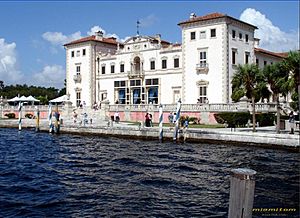
Coconut Grove hosts many outdoor festivals. The most famous is the annual Coconut Grove Arts Festival. Another fun event is the King Mango Strut. It's a funny parade that happens every December. The Great Taste of the Grove Food & Wine Festival is in April.
In June, the Goombay Festival takes over Grand Avenue. It's a big celebration of Bahamian culture. You can enjoy Bahamian food and Caribbean music.
The Grove has many restaurants and cafes. Some are open-air, perfect for enjoying the weather. There are also waterfront restaurants and bars. At night, Coconut Grove is a lively place. Locals, students, and tourists enjoy the nightlife.
You can find lots of places to shop in the Grove. There are two open-air malls: CocoWalk and the Streets of Mayfair. Many other street shops and boutiques are also there.
The main shopping and dining area is called the Village Center. It has gyms, a movie theater in CocoWalk, and parking garages. You can also find a historic site, an elementary school, and the post office. Large condos and parks are also part of this busy area.
Many big companies have offices in Coconut Grove. These include Arquitectonica, Spanish Broadcasting System, and Watsco.
The eastern side of Coconut Grove is on Biscayne Bay. This makes it a great place for boating and sailing. There are several clubs like the Coconut Grove Sailing Club. The Biscayne Bay Yacht Club is also here. Dinner Key Marina is a large city marina. The Pan Am seaplane base used to be at Dinner Key. Today, the Miami City Hall is in the old Pan Am terminal building.
Who Lives Here: Demographics
Coconut Grove is divided into "Northeast Coconut Grove" and "Southwest Coconut Grove." In 2000, about 19,000 to 20,000 people lived here. The main ZIP Codes are 33129 and 33133. The area covers about 5.607 square miles (14.52 km2).
The "West" Grove, also called Black Grove, has many people of Afro-Bahamian descent. Bahamian sailors were among the first people to settle in this area. The Goombay festival celebrates the rich history of this Bahamian neighborhood.
Getting Around: Transportation
Coconut Grove is served by Metrobus routes. You can also use the Miami Metrorail at these stations:
- Vizcaya (near SW 32nd Road and U.S. 1)
- Coconut Grove (near SW 27th Avenue and U.S. 1)
- Douglas Road (near SW 37th Avenue and U.S. 1)
The Metrobus' Coconut Grove Connection links to the Metrorail stations. It takes you to popular spots like CocoWalk and Peacock Park.
Learning and Culture: Education and Institutions
Cultural Places to Visit
- Coconut Grove Playhouse
- Marjory Stoneman Douglas Home
- The Barnacle Historic State Park
- The Kampong
- Vizcaya Museum and Gardens
Libraries in the Grove
- Miami-Dade Public Library runs the local public libraries.
Schools in Coconut Grove
Elementary Schools
Miami-Dade County Public Schools operates these public elementary schools:
- Coconut Grove Elementary School
- Frances S. Tucker Elementary School
- George W. Carver Elementary School
Middle Schools
- George Washington Carver School is in Coral Gables. However, it also serves students from Coconut Grove.
High Schools
- George Washington Carver School
Private Schools
- Ransom Everglades School, founded in 1903
- St. Hugh Catholic School, 1956
- Immaculata-Lasalle High School, 1958
- St. Stephen's Episcopal Day School, 1958
- Carrollton School of the Sacred Heart, 1961
- Coconut Grove Montessori School
- Vanguard School
Cool Spots: Points of Interest
- Charles Avenue
- CocoWalk
- Dinner Key
- First Coconut Grove School
- Grove Isle
- Mercy Hospital
- Miami City Hall
- Plymouth Congregational Church
- Trapp Homestead
- Woman's Club of Coconut Grove
Green Spaces: Parks
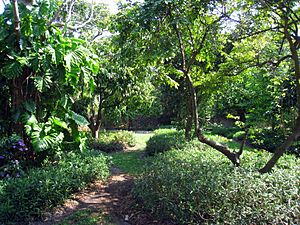
- The Kampong: This is an 8-acre tropical garden. It is part of the National Tropical Botanical Garden.
- The Barnacle Historic State Park: This park has the oldest house in Miami-Dade County. It was built in the late 1800s. It was the home of Ralph Middleton Munroe. The park has a special forest called a tropical hardwood hammock.
- Peacock Park and Kenneth Myers Bayside Park
- David Kennedy Park
- Merrie Christmas Park
- Steele Park
- Blanche Park
- Elizabeth Virrick Park
- Kirk Munroe Park
- Coconut Grove Park
- Grand Avenue Park
- Ingraham Terrace Park
- Sunrise Park
- Marjory Stoneman Douglas Mini Park
- Dinner Key Picnic Islands Park
- Alice Wainwright Park
Famous Faces: Notable People
Many well-known people have lived or live in Coconut Grove:
|
|
Old Buildings: Historic Coconut Grove
Coconut Grove was settled in 1825. Because of this, it has many of Miami's oldest buildings and homes. Some of these include:
-
Trapp Homestead, 1887
-
Dinner Key, 1917
-
Villa Vizcaya, 1914–23
-
Sweeney House at The Kampong, 1916
-
The Barnacle at The Barnacle Historic State Park, 1891
See also
 In Spanish: Coconut Grove (Miami) para niños
In Spanish: Coconut Grove (Miami) para niños


